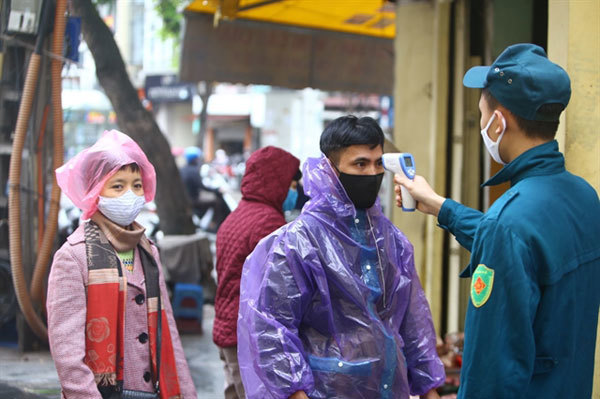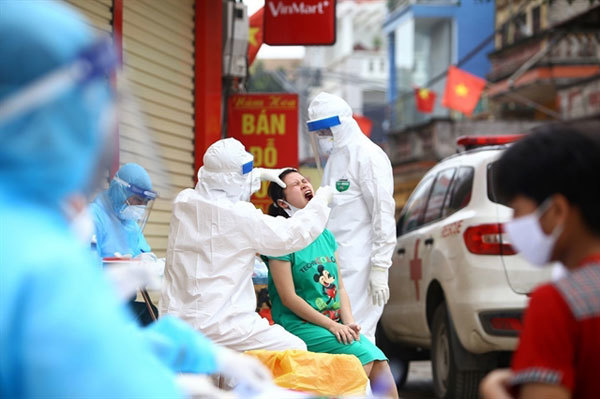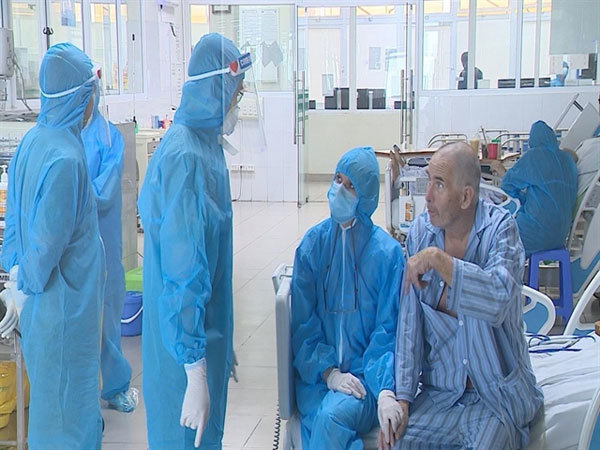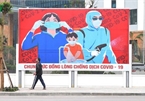 |
| People have their temperatures checked before entering a market on Yen Thai Street in the Old Quarter of Hanoi. — VNA/VNS Photo |
Strict mass quarantine, intensive contact tracing, early sealing off of borders with virus-hit regions, decisive leadership and social unity were variously cited as the reasons for Vietnam’s initial successes against the onslaught of the novel coronavirus despite having limited resources, while many other advanced nations buckle under an explosion of patients with deaths running up to the thousands.
As of April 15, Vietnam has 267 confirmed COVID-19 cases by 6pm yesterday since the first cases were reported on January 23, with more than half of them foreigners or Vietnamese returning from overseas and 60 per cent of the cases already recovered. Only 96 active cases remain in treatment, and the country has upheld the envious record of zero deaths for months now.
Nearly 133,000 tests have been conducted to date, while nearly 68,000 people who either recently returned from virus-hit regions or have close contacts with confirmed cases are currently placed under quarantine – including 533 under close observation in hospitals.
Kidong Park, the World Health Organisation’s representative to Vietnam, noted that Vietnam’s success can be attributed to its swift and early response to the virus, with the first risk assessment drill held in early January, just when the first reports of a mysterious pneumonia-like disease in China started to crop up.
The WHO official has also lauded Vietnam for its “proactiveness and consistency throughout the response,” while the US ambassador to Vietnam Daniel Kritenbrink has hailed the Vietnamese Government for its outstanding response to the disease and for its cooperation and transparency.
Vietnam’s Prime Minister Nguyen Xuan Phuc declared the novel coronavirus outbreak an epidemic and officially grounded all flights to and from China at the beginning of February. The land borders have been frequently patrolled to prevent illegal entries.
Thanks to the early actions that were seen by Harvard infectious disease expert Todd Pollack as inspired by its experience during the SARS outbreak in 2003, Vietnam’s official tally in the “first wave” of virus infections – colloquially used to refer to the domestically reported cases that traced back to China when Wuhan remained the epicentre of the COVID-19 – stood at merely 16.
The 16th case was confirmed on February 13. The country enjoyed a relative lull with no new cases until March 6, when a Vietnamese socialite tested positive for the virus after visiting Italy and the UK, marking the beginning of the so-called “second wave” of infections where the new epicentre of the outbreak started to shift to European countries and the spike in new positive cases in Vietnam were imported.
Starting March 15, the country started to deny entry from UK and Schengen countries before closing down its border completely for foreign entries on March 22 as quarantine sites started to burgeon due to its strict 14-day compulsory quarantine policy for all arrivals.
The ASEAN Post noted how Vietnam has implemented strict contact tracing measures to break up transmission chains, stamp out local outbreaks and prevent widespread community transmission.
“Mass testing is good, but it depends on the resources of each country,” said Tran Dac Phu, a senior health official advising Vietnam’s Emergency Operation Centre, likely referring to the mass testing strategy that the more technologically advanced South Korea and the US have been doing when their case numbers spike.
“Vietnam has successfully conducted tracing via the quick identification of infectious contacts based on the Ministry of Health’s classifications of infected, suspected, and exposed cases of COVID-19 and the rapid mobilisation of health professionals, public security personnel, the military, and civil servants to implement the tracing,” noted the Asia Pacific Foundation of Canada in its report.
The Financial Times offered an insight into how Vietnam has earned praise the world over for a “low-cost model” in its offensive against SARS-CoV-2, again citing stringent isolation, contact tracing measures and “determined leadership” for the country’s successes.
During the outbreak, Vietnam's health ministry in cooperation with telecom giants have rolled out the nCoV app available on both mobile platforms Android and iOS. Bundled inside the app is updated information on the pandemic situation in the country and the world, official links to information resources on the disease, electronic health declaration forms, a map of all detected infection cases and clusters, and reporting of suspected cases. The user can watch the movement of all those placed under quarantine.
Despite low cases, the Vietnamese Government repeatedly urged vigilance and reiterated messages of protective measures – staying home, avoiding large gatherings, wearing masks, washing hands – in all forms of media to the public on various platforms.
On April 1, the Government decided to put the whole country under a 15-day social distancing order, which it insisted was not a lockdown, but more of a call for voluntary compliance when the caseload reached 212 but showed worrying signs of community spread.
Germany news agency Deutsche Presse-Agentur wrote Vietnam did so to "prevent an avoidable national crisis" unlike in other countries that imposed lockdowns when the outbreak already hit disaster level and case number reached thousands.
Even then, life and most activities in Vietnam were already significantly disrupted since early February.
Schools in Vietnam, supposed to resume on February 6 after the traditional Tet (Lunar New Year) holidays, remained closed until this day and likely at least until the end of April, while non-essential businesses were ready to be closed anytime during March.
But apparently, these seeming overactions have benefited the entire country’s public health, which could mean the country would spring back into action early and robustly when the pandemic blows over.
It’s worth noting that all Government’s efforts could not have been as successful without the full buy-in from the whole population.
In a recent report from Infocus Mekong Research, 90 per cent of Vietnamese are in favour of “better safe than sorry” measures and want social distancing measures to be extended, despite the tremendous toll on the economy, livelihoods and ways of life.
In late March, Vietnamese people have shown to have the most confidence in the Government’s response, with 62 per cent of those surveyed by Dalia Research in a large-scale global public opinion study on COVID-19 saying that the Government was doing the “right amount” of actions to combat the outbreak.
The Guardian ran an article entitled “'In a war, we draw': Vietnam artists join fight against COVID-19,” in which numerous Vietnamese artists were described as contributors to national efforts in containing the outbreak by crafting paintings that employ traditional wartime propaganda aesthetics to convey pandemic-relevant messages, from hygiene tips, encouragement to frontline doctors and nurses, to showcasing the people’s resilience in this challenging time.
 |
| Health workers collect samples from people living in Ha Loi Village with a population of 10,000 outside of Hanoi. The city has ramped up mass testing after a dozen cases were found to have connected to the rural village. — VNA/VNS Photo |
No one behind
Prime Minister Nguyen Xuan Phuc has more than once said that the Vietnamese Government is doing its best to walk the fine balance between maintaining its stellar growth records while ensuring public health, but insisted that the priority is always on the latter even if it means sacrificing growth, in the spirit of leaving no one behind.
Vietnam's success is not a miracle but "the result of a heavily planned economy with a socialist government that puts people over profits," Liberation News site remarked.
All of the stringent and early measures it adopted – painful and difficult as they are – might not only spare Vietnam from the devastation witnessed in the west and elsewhere, but also put Vietnam ahead in the road of revival.
The COVID-19 global safety ranking released on April 12 by the Hong Kong-based Deep Knowledge Ventures has placed Vietnam at 20th position, becoming the only developing country in the world’s top 20 safest entries, only behind highly developed nations and economic powerhouses like Germany, Israel, Canada, UAE, South Korea or China.
Similarly, East Asia Forum ran an article on April 14 saying that Vietnam has been one of Asia’s most successful in dealing with the pandemic.
“Despite expected growth in 2020 falling to 4.9 per cent, it is among only a few economies in Asia Pacific – and perhaps the world – to still post growth,” it wrote.
“The Asian Development Bank, while predicting a sharp decline in GDP growth in Vietnam, said its economy remains ‘uniquely robust’ in the subregion,” it went on, adding that Vietnam’s success in curbing the virus spread may attract more foreign investors, as will its traditional advantages of cheap labour, political stability, and proximity to China.
The low number of cases in Vietnam is not just a statistical achievement, it also means less stress for frontline healthcare workers and a higher chance of recovery and survival for patients as they could receive the medical attention that they need.
A 43-year-old British pilot, Vietnam’s COVID-19 patient No 91, admitted to Cho Ray Hospital in HCM City a month ago remains in critical condition. The complicated path of his condition – blood coagulation, surviving on ECMO (Extracorporeal Membrane Oxygenation), stopping breathing multiple times, and the fact that his body’s autoimmune system is mistakenly carrying out assaults on his own lungs in an exaggerated response to the presence of the SARS-CoV-2 virus – has put him near death’s door several times.
Fortunately, he is enjoying the full expertise from Vietnam’s best doctors: telehealth meetings are held frequently among leading public hospitals in the country to determine necessary steps in response to any emergency.
The health ministry said it is placing an order for a “particular drug” from overseas to treat the patient’s coagulation, as his condition does not respond to any existing drugs available in Vietnam.
Arguably, all these extraordinary steps just to save a single patient would hardly have been possible were the doctors overwhelmed by a patient deluge and unable to cater to everyone's needs.
 |
| Two of Vietnam's COVID-19 patients, a British couple - 74-year-old man and his wife - talk to doctors at National Hospital of Tropical Diseases in Hanoi. — VNA/VNS Photo |
A British former nurse – together with her husband – were declared clear of the virus and discharged from the Tropical Diseases Hospital in Hanoi on Tuesday, weeks after her 74-year-old husband was admitted to the intensive care unit as he became one of the rare critical cases in Vietnam.
Upon leaving the hospital and preparing to fly home later that day, she exuberantly thanked Vietnamese medical teams, telling local media that: “If we got sick in Britain, we might not have been saved,” which was probably prompted by grim reports of the COVID-19 situation in her home country where a dire shortage of life-support machines and ventilators might force her colleagues to make the harrowing decision of choosing who has the best chance of living.
A relatively controlled spread domestically also puts Việt Nam at a place where it could comfortably extend help to its friends and partners.
As a show of solidarity, the Vietnamese Government has donated 555,000 antibacterial masks to five European countries hit hardest by the virus, and aid and medical supplies to China during the epidemic’s peak, and later to Laos, Cambodia, and Myanmar (not counting several other smaller scale donations made by Vietnamese agencies and communities to these countries and others).
Drawing comparison to China’s “face mask diplomacy” in which China sent masks, PPE or test kits to nearly 90 countries to help them deal with the pandemic, Professor Carl Thayer, Emeritus Professor at the Australian Defence Force Academy in Canberra, commented that while Vietnam can't “match China in the volume and dollar value of its aid but it can provide assistance where it counts.” — VNS

Streets of Hanoi filled with informative messages to aid fight against COVID-19
Plenty of colourful posters can be seen on streets throughout Hanoi, all of which send messages of unity to the capital’s citizens and encouragement to push back the novel coronavirus (COVID-19) epidemic.

More than 90 startups in Vietnam join hands to fight against Covid-19
Ninety-three projects and startups are ready to provide technological solutions to help solve problems and assist frontline workers, isolated communities and indirectly affected people.
 As the global number of COVID-19 cases surpasses the two million milestone, Vietnam has started to receive international accolades for its all-out efforts that have managed to keep its tally considerably low given its close proximity to China.
As the global number of COVID-19 cases surpasses the two million milestone, Vietnam has started to receive international accolades for its all-out efforts that have managed to keep its tally considerably low given its close proximity to China.